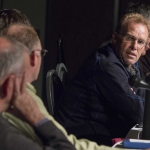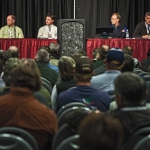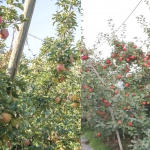Which is the best way to grow apples—on a vertical or angled canopy? It depends who you ask.
During a debate at the Washington State Horticultural Association’s annual meeting, growers leaned towards an angled system, while researchers stood up for the vertical approach.
Dr. Terence Robinson, horticulturist with Cornell University, New York, said he favors the vertical tall spindle system partly because of its simplicity and partly because he believes it has the potential to be the most profitable system, if everything goes right.
It is simple because it uses the natural characteristics of the apple tree. It is easy to manage and can produce high-quality fruit without the expense of a lot of branch manipulation, said Robinson, who has been experimenting with the system since 1991.
“If you start with a very nice tree, it’s almost an instant orchard,” he said. “It will start producing fruit without you doing very much. I say it’s as easy as getting up in the morning and falling out of bed to grow the tall spindle.”
Limb removal
The system is based on keeping the diameter of the branches small. The tree has fairly substantial scaffold branches in the first two to five years. Then begins the process of eliminating one or two of the large branches every year.
Robinson acknowledged that varieties differ in their response to limb removal. Some varieties generate better renewal shoots from those cuts than others, but the response also is related to the vigor of the tree.
For example, if it’s a low-vigor Honeycrisp tree, it might be difficult to get replacement shoots to pop out, so the tree might need to be kept more vigorous than otherwise. Robinson used to remove limbs with angled cuts fairly close to the trunk, but he now recommends leaving longer stubs to encourage regrowth.
Trees are not headed at planting. Nurseries might tip the trees for shipping, but should be encouraged not to. Most of the time, the trees will grow well, but occasionally, the leader will set a terminal flower bud. Robinson said this should be eliminated as soon as possible.
He stressed that heading is not a solution for a tree that’s slow to grow.
“You might think you’re getting a lot of growth when you head, but it basically grows back to where it was before. You don’t make the tree bigger,” he said.
Better solutions for promoting tree growth are to intensively manage water and nitrogen applications for the first two years.
Dr. Stefano Musacchi, horticulturist with Washington State University, has been focusing for the past several years on biaxis trees grown in a fruiting wall system.
Thin canopies maximize light interception, which usually maximizes dry matter, and that’s important because 70 percent of the dry matter the tree produces goes to the fruit. If the canopy is more than three feet deep, there can be problems with shading, lack of fruit buds, and poor-coloring fruit in the interior of the canopy.
In the biaxis system, each tree is grown with two leaders, rather than one trunk, which helps divide the tree’s energies and control its vigor, particularly in fertile soils.
Other advantages of the two-dimensional system include high productivity, less shading, better fruit color, uniform production throughout the canopy, and the potential for mechanical pruning and thinning.
Musacchi said mechanization is a key issue. Platforms are becoming the most important equipment in the orchard because they can be used for pruning, hanging pheromone dispensers, harvesting, and other orchard tasks.
Mechanical pruning in summer, timed when the shoots have 12 leaves, has a very positive effect on flower bud formation, he reported. It also reduces the need for pruning in winter, a time when it will stimulate strong regrowth.
Summer pruning can be done mechanically with only six hours of labor per acre. In the winter, all that’s needed is touchup pruning, which is relatively inexpensive.
Higher production
John Verbrugge, owner of Valley Fruit Orchards based in Wapato, Washington, said he favors angled canopies because of greater light penetration in the bottom of the tree and higher production. He also feels he’s better able to optimize the amount of size 72 to 80 premium fruit, the sizes and grade the market prefers.
“There’s a lot of opportunity to hit the sweet spot better than what we’ve seen on the spindle systems,” he said.
Although a V system is more expensive to establish, it pays off because keeping the tree trained to the wires creates efficiencies, Verbrugge said. “It’s easy to tell people that branches stay on the wire and nothing in between—that’s how you prune and that’s how you train.”
He estimates training costs for the first couple of years at about $1,000 per acre and expects to see a payback on the planting by year seven if production goals are met.
Verbrugge, who farms in the Royal City and Othello areas as well as Wapato, said he plans to keep planting angled systems, even though vertical systems might be more suited to mechanization.
He’s tried using platforms for thinning and pruning, but finds that individuals on ladders can get the job done more quickly because a platform with six people on it can only move as fast as the slowest worker.
When a block has a crop of 80 to 100 bins per acre, there is no shortage of people wanting to pick it, even from ladders, he said.
His next planting will be a Tatura system angled 15 degrees from vertical with trees planted 22 inches apart and 13 feet between rows.
Open V
Another angled-system fan is Bruce Allen, president of the growing and packing operation Columbia Reach in Yakima, Washington. He began switching from a spindle system to an open V system about 20 years ago because he found angled canopies to be more productive.
He settled on a system where each tree has two leaders with one trained to either side of the V. The rows are 13 feet apart, and he tries to keep four feet of open space at the top.
The main reason for the high productivity of the V is the greater canopy volume compared with a fruiting wall, for example.
In 2014, he will plant formal and informal Vs, but also some vertical plantings, which are more accessible and provide more opportunity for mechanical aids.
“We’ve fiddled around with various mechanical assists for probably ten to fifteen years,” Allen said. “We’ve had a lot of problems finding ones that fit our particular system because our angled V is fairly low, with tight spacing. The machines weren’t designed to fit it,” he said.
“I prefer the V, but I’m experimenting with the vertical system because I think it might be easier to mechanize and I think the tradeoff is probably slightly lower yields, but I might gain that back in more efficient production practices.”
Challenge
Robinson said growers can be successful with many different systems. “You have to find a system you like,” he said.
When he’s made head-to-head comparisons of angled and vertical systems, as long as the light interception is equivalent, the yields are the same, he said. “I just think I can do it cheaper and in a less complicated way in a vertical system.”
In his opinion, the only reason to plant a V system would be to reduce sunburn and that’s not something he’s been able to study since sunburn is not a problem in New York.
He challenged Washington researchers to prove, in a long-term study, that a V system is more productive with the same variety on the same rootstock and with comparable light interception. •









Leave A Comment